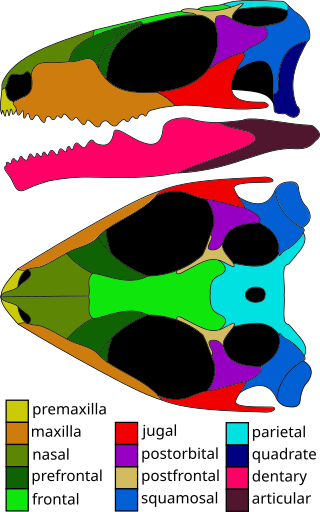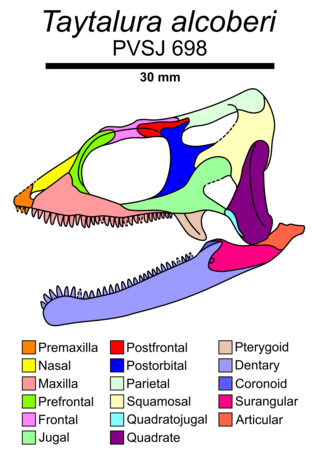
Rhynchocephalia is an order of lizard-like reptiles that includes only one living species, the tuatara of New Zealand. Despite its current lack of diversity, during the Mesozoic rhynchocephalians were a speciose group with high morphological and ecological diversity. The oldest record of the group is dated to the Middle Triassic around 238 to 240 million years ago, and they had achieved global distribution by the Early Jurassic. Most rhynchocephalians belong to the group Sphenodontia ('wedge-teeth'). Their closest living relatives are lizards and snakes in the order Squamata, with the two orders being grouped together in the superorder Lepidosauria.

Elachistosuchus is an extinct genus of neodiapsid reptile, most likely basal archosauromorph, known from the Late Triassic Arnstadt Formation of Saxony-Anhalt, central Germany. It contains a single species, Elachistosuchus huenei, known from a single individual E. huenei, originally considered a pseudosuchian archosaur and then a rhynchocephalian lepidosaur, was largely ignored in the scientific literature, as its small size and fragility did not permit further mechanical preparation and examination. More recently however, a non-invasive μCT scanning was performed to resolve its placement within Reptilia, and found it to represent a more basal reptile, potentially closely related to several early archosauromorph clades.

Planocephalosaurus is an extinct genus of basal rhynchocephalian. Fossils of the genus are primarily known from fissure fill deposits from the Late Triassic of southwest Britain, with fragmentary remains possibly belonging to the genus also known from the Late Triassic of Texas.

Brachyrhinodon is an extinct genus of sphenodontian from the Late Triassic Lossiemouth Sandstone of Scotland.

Clevosaurus is an extinct genus of rhynchocephalian reptile from the Late Triassic and the Early Jurassic periods. Species of Clevosaurus were widespread across Pangaea, and have been found on all continents except Australia and Antarctica. Five species of Clevosaurus have been found in ancient fissure fill deposits in south-west England and Wales, alongside other sphenodontians, early mammals and dinosaurs. In regards to its Pangaean distribution, C. hadroprodon is the oldest record of a sphenodontian from Gondwana, though its affinity to Clevosaurus has been questioned.

Diphydontosaurus is an extinct genus of small rhynchocephalian reptile from the Late Triassic of Europe. It is the most primitive known member of Sphenodontia.

Gephyrosauridae is an extinct family of rhynchocephalians that lived in the Late Triassic and Early Jurassic. They are generally considered to be rhynchocephalians that lie outside of Sphenodontia, but in some analyses they are recovered as more closely related to squamates than to sphenodontians.

Gephyrosaurus is an extinct genus of lepidosaurian reptile known from the Late Triassic to Early Jurassic of the United Kingdom. It is generally considered to be one of the most primitive members of the clade Rhynchocephalia.
Godavarisaurus is an extinct genus of sphenodontian reptile from the Early-Middle Jurassic Kota Formation of Andhra Pradesh, India. It is known from jaw fragments. It was a small sphenodontian, with the skull estimated to be less than 2 centimetres (0.79 in) long. It is generally considered to be a relatively basal sphenodontian that lies outside Eusphenodontia.

Sphenotitan is an extinct genus of rhynchocephalian reptile, known from the Late Triassic (Norian) Quebrada del Barro Formation of Argentina. It is the earliest known member of the herbivorous Elienodontinae, and the only one known from the Triassic. It was a large-sized sphenodontian, with an estimated skull length of over 10 centimetres (3.9 in). The skull is roughly triangular in shape, and had large upper temporal fenestrae. The region of the skull in front of the eye socket is short. The premaxillae forms beak, with a cutting edge similar to a chisel. The teeth of Sphenotitan, like other elienodontines, were large and wide, and designed for shredding vegetation, with blade-like palatal teeth on the roof of the mouth.
Rebbanasaurus is an extinct sphenodontian reptile known from remains found in the Early-Middle Jurassic Kota Formation of India. The type specimen is a partial jawbone which has acrodont teeth, with other known remains including fragments of the premaxilla, maxilla, and palatine. It was relatively small, with a skull estimated at 1.5–2.5 centimetres (0.59–0.98 in) long. It is generally considered to be a relatively basal sphenodontian that lies outside Eusphenodontia.

Opisthodontia is a proposed clade of sphenodontian reptiles, uniting Opisthias from the Late Jurassic-earliest Cretaceous of Europe and North America with the Eilenodontinae, a group of herbivorous sphenodontians known from the Late Triassic to Late Cretaceous.
Palacrodon is an extinct genus of Triassic reptile with a widespread distribution. It was initially described from teeth collected in Early Triassic deposits in South Africa, and later reported from the Early Triassic of Antarctica and the Late Triassic of Arizona. Although previously considered an early rhynchocephalian, it is currently considered to be a non-saurian neodiapsid.

Clevosaurs are an extinct group of rhynchocephalian reptiles from the Triassic and Jurassic periods.

Polysphenodon is an extinct genus of sphenodontian reptile with a single species Polysphenodon mulleri from the Late Triassic Keuper Group of Germany.

Colobops is a genus of reptile from the Late Triassic of Connecticut. Only known from a tiny skull, this reptile has been interpreted to possess skull attachments for very strong jaw muscles. This may have given it a very strong bite, despite its small size. However, under some interpretations of the CT scan data, Colobops's bite force may not have been unusual compared to other reptiles. The generic name, Colobops, is a combination of κολοβός, meaning shortened, and ὤψ, meaning face. This translation, "shortened face", refers to its short and triangular skull. Colobops is known from a single species, Colobops noviportensis. The specific name, noviportensis, is a latinization of New Haven, the name of both the geological setting of its discovery as well as a nearby large city. The phylogenetic relations of Colobops are controversial. Its skull shares many features with those of the group Rhynchosauria, herbivorous archosauromorphs distantly related to crocodilians and dinosaurs. However, many of these features also resemble the skulls of the group Rhynchocephalia, an ancient order of reptiles including the modern tuatara, Sphenodon. Although rhynchosaurs and rhynchocephalians are not closely related and have many differences in the skeleton as a whole, their skulls are remarkably similar. As Colobops is only known from a skull, it is not certain which one of these groups it belonged to. Pritchard et al. (2018) interpreted it as a basal rhynchosaur, while Scheyer et al. (2020) reinterpreted it as a rhynchocephalian.

Taytalura is an extinct genus of lepidosauromorph reptile from the Late Triassic of Argentina. It contains a single species, Taytalura alcoberi, which is based on a well-preserved skull from the fossiliferous Ischigualasto Formation. As a lepidosauromorph, Taytalura is a distant relative of modern lepidosaurs such as sphenodontians and squamates. Taytalura did not belong to any group of modern lepidosaurs, since it bears unique features, such as unfused bones in the skull roof and teeth which all sit loosely in a deep groove without sockets. Regardless, Micro-CT scanning reveals features of the skull previously only seen in rhynchocephalians. This suggests that the ancestral condition of the skull in lepidosaurs was more similar to sphenodonts than to squamates.
Lanceirosphenodon is an extinct genus of sphenodontian from the Late Triassic Candelária Formation of Brazil. It contains a single species, Lanceirosphenodon ferigoloi.
Deltadectes is an extinct genus of early rhynchocephalian from the Late Triassic Klettgau Formation of Switzerland. It contains a single species, Deltadectes elvetica.
Paleollanosaurus is an extinct genus of sphenodontian reptile that lived during the Late Triassic. The type species P. fraseri was described from a jaw fragment found in West Texas in North America. Remains have also been reported from Switzerland. It is generally considered a basal sphenodontian. Cladogram following Chambi-Trowell et al., 2021.












